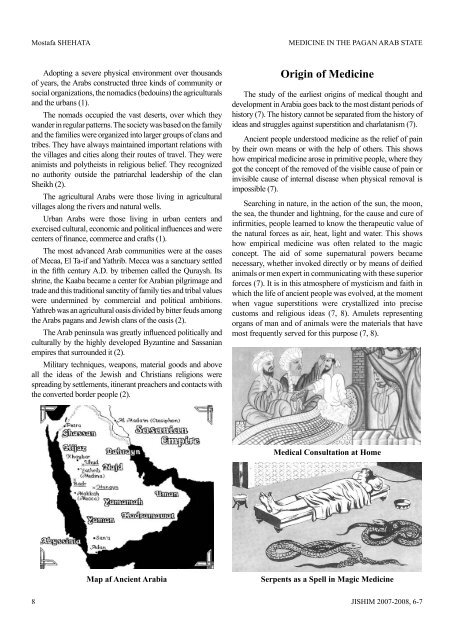Journal of International Society for the History
Journal of International Society for the History
Journal of International Society for the History
Create successful ePaper yourself
Turn your PDF publications into a flip-book with our unique Google optimized e-Paper software.
Mostafa SHEHATA MEDICINE IN THE PAGAN ARAB STATE<br />
Adopting a severe physical environment over thousands<br />
<strong>of</strong> years, <strong>the</strong> Arabs constructed three kinds <strong>of</strong> community or<br />
social organizations, <strong>the</strong> nomadics (bedouins) <strong>the</strong> agriculturals<br />
and <strong>the</strong> urbans (1).<br />
The nomads occupied <strong>the</strong> vast deserts, over which <strong>the</strong>y<br />
wander in regular patterns. The society was based on <strong>the</strong> family<br />
and <strong>the</strong> families were organized into larger groups <strong>of</strong> clans and<br />
tribes. They have always maintained important relations with<br />
<strong>the</strong> villages and cities along <strong>the</strong>ir routes <strong>of</strong> travel. They were<br />
animists and poly<strong>the</strong>ists in religious belief. They recognized<br />
no authority outside <strong>the</strong> patriarchal leadership <strong>of</strong> <strong>the</strong> clan<br />
Sheikh (2).<br />
The agricultural Arabs were those living in agricultural<br />
villages along <strong>the</strong> rivers and natural wells.<br />
Urban Arabs were those living in urban centers and<br />
exercised cultural, economic and political infl uences and were<br />
centers <strong>of</strong> fi nance, commerce and crafts (1).<br />
The most advanced Arab communities were at <strong>the</strong> oases<br />
<strong>of</strong> Mecaa, El Ta-if and Yathrib. Mecca was a sanctuary settled<br />
in <strong>the</strong> fi fth century A.D. by tribemen called <strong>the</strong> Quraysh. Its<br />
shrine, <strong>the</strong> Kaaba became a center <strong>for</strong> Arabian pilgrimage and<br />
trade and this traditional sanctity <strong>of</strong> family ties and tribal values<br />
were undermined by commercial and political ambitions.<br />
Yathreb was an agricultural oasis divided by bitter feuds among<br />
<strong>the</strong> Arabs pagans and Jewish clans <strong>of</strong> <strong>the</strong> oasis (2).<br />
The Arab peninsula was greatly infl uenced politically and<br />
culturally by <strong>the</strong> highly developed Byzantine and Sassanian<br />
empires that surrounded it (2).<br />
Military techniques, weapons, material goods and above<br />
all <strong>the</strong> ideas <strong>of</strong> <strong>the</strong> Jewish and Christians religions were<br />
spreading by settlements, itinerant preachers and contacts with<br />
<strong>the</strong> converted border people (2).<br />
Map af Ancient Arabia<br />
Origin <strong>of</strong> Medicine<br />
The study <strong>of</strong> <strong>the</strong> earliest origins <strong>of</strong> medical thought and<br />
development in Arabia goes back to <strong>the</strong> most distant periods <strong>of</strong><br />
history (7). The history cannot be separated from <strong>the</strong> history <strong>of</strong><br />
ideas and struggles against superstition and charlatanism (7).<br />
Ancient people understood medicine as <strong>the</strong> relief <strong>of</strong> pain<br />
by <strong>the</strong>ir own means or with <strong>the</strong> help <strong>of</strong> o<strong>the</strong>rs. This shows<br />
how empirical medicine arose in primitive people, where <strong>the</strong>y<br />
got <strong>the</strong> concept <strong>of</strong> <strong>the</strong> removed <strong>of</strong> <strong>the</strong> visible cause <strong>of</strong> pain or<br />
invisible cause <strong>of</strong> internal disease when physical removal is<br />
impossible (7).<br />
Searching in nature, in <strong>the</strong> action <strong>of</strong> <strong>the</strong> sun, <strong>the</strong> moon,<br />
<strong>the</strong> sea, <strong>the</strong> thunder and lightning, <strong>for</strong> <strong>the</strong> cause and cure <strong>of</strong><br />
infi rmities, people learned to know <strong>the</strong> <strong>the</strong>rapeutic value <strong>of</strong><br />
<strong>the</strong> natural <strong>for</strong>ces as air, heat, light and water. This shows<br />
how empirical medicine was <strong>of</strong>ten related to <strong>the</strong> magic<br />
concept. The aid <strong>of</strong> some supernatural powers became<br />
necessary, whe<strong>the</strong>r invoked directly or by means <strong>of</strong> deifi ed<br />
animals or men expert in communicating with <strong>the</strong>se superior<br />
<strong>for</strong>ces (7). It is in this atmosphere <strong>of</strong> mysticism and faith in<br />
which <strong>the</strong> life <strong>of</strong> ancient people was evolved, at <strong>the</strong> moment<br />
when vague superstitions were crystallized into precise<br />
customs and religious ideas (7, 8). Amulets representing<br />
organs <strong>of</strong> man and <strong>of</strong> animals were <strong>the</strong> materials that have<br />
most frequently served <strong>for</strong> this purpose (7, 8).<br />
Medical Consultation at Home<br />
Serpents as a Spell in Magic Medicine<br />
8 JISHIM 2007-2008, 6-7

















